PSY2010 Abnormal Psychology: Annotated Bibliography on Mental Health
VerifiedAdded on 2023/05/29
|9
|2023
|349
Annotated Bibliography
AI Summary
This annotated bibliography presents a review of current research on schizophrenia spectrum disorders and depressive disorders, drawing from the DSM-5 categorization. The bibliography includes summaries and evaluations of research articles focusing on family burden in schizophrenia, stigma and discrimination in healthcare settings, gender differences in the age of onset of schizophrenia, and predictors of functioning in bipolar disorder. Furthermore, it delves into the risk of mental illness in offspring of parents with schizophrenia, bipolar disorder, and major depressive disorder, as well as the impairment of Theory of Mind in bipolar disorder. Each annotation includes a concise summary of the study's objectives, methods, and findings, followed by an evaluation of the study's strengths, limitations, and relevance to the broader understanding of these mental disorders. Desklib is a platform where you can find more such documents and study resources.
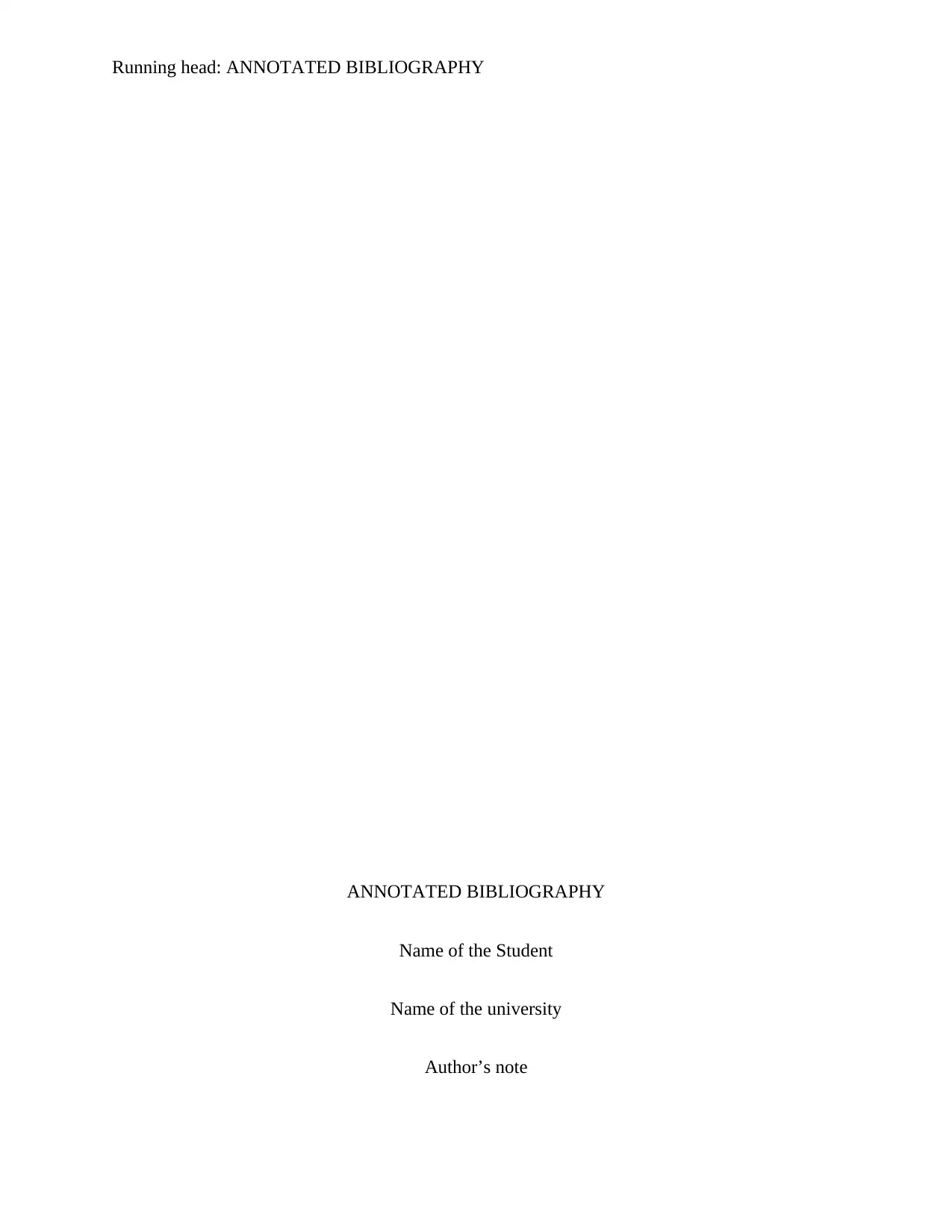
Running head: ANNOTATED BIBLIOGRAPHY
ANNOTATED BIBLIOGRAPHY
Name of the Student
Name of the university
Author’s note
ANNOTATED BIBLIOGRAPHY
Name of the Student
Name of the university
Author’s note
Paraphrase This Document
Need a fresh take? Get an instant paraphrase of this document with our AI Paraphraser
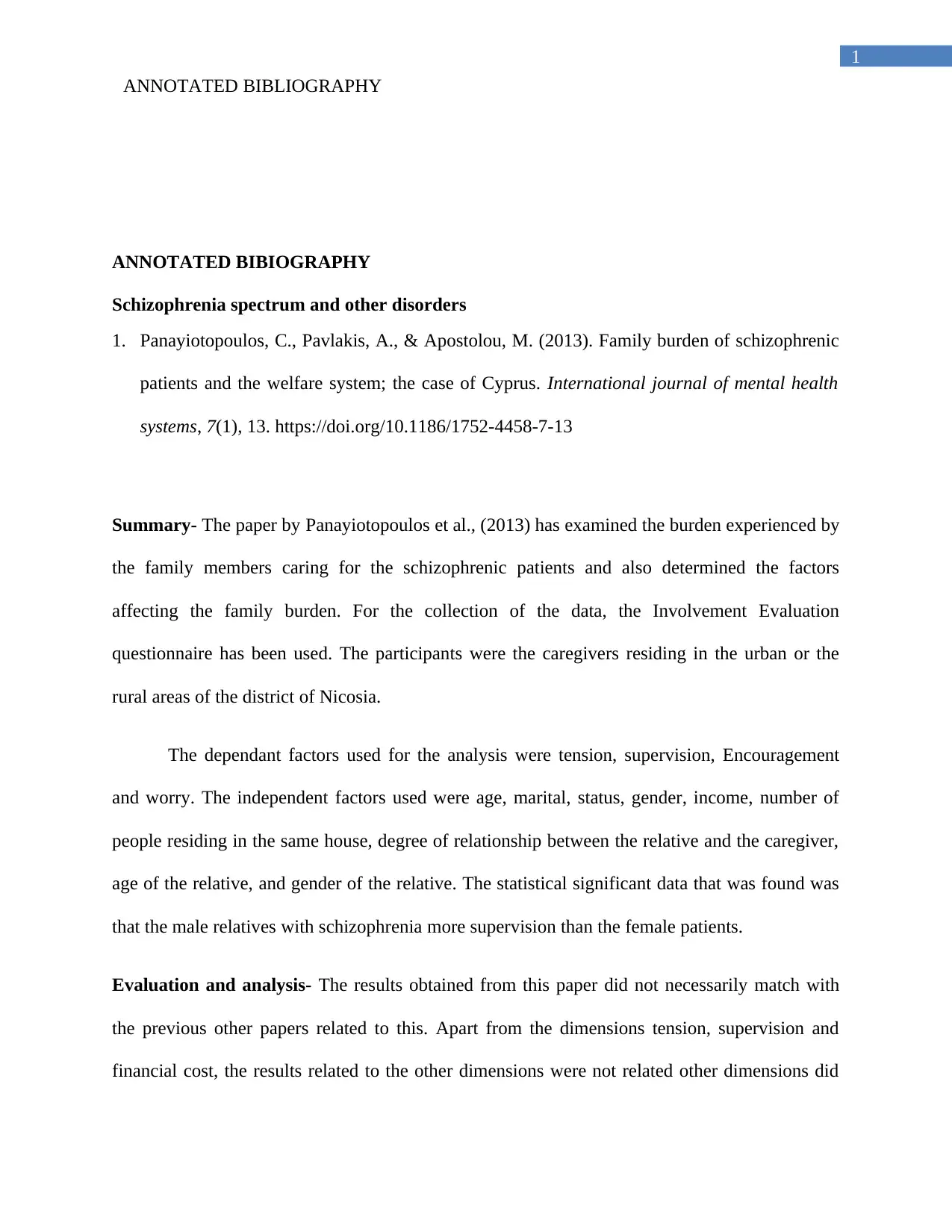
1
ANNOTATED BIBLIOGRAPHY
ANNOTATED BIBIOGRAPHY
Schizophrenia spectrum and other disorders
1. Panayiotopoulos, C., Pavlakis, A., & Apostolou, M. (2013). Family burden of schizophrenic
patients and the welfare system; the case of Cyprus. International journal of mental health
systems, 7(1), 13. https://doi.org/10.1186/1752-4458-7-13
Summary- The paper by Panayiotopoulos et al., (2013) has examined the burden experienced by
the family members caring for the schizophrenic patients and also determined the factors
affecting the family burden. For the collection of the data, the Involvement Evaluation
questionnaire has been used. The participants were the caregivers residing in the urban or the
rural areas of the district of Nicosia.
The dependant factors used for the analysis were tension, supervision, Encouragement
and worry. The independent factors used were age, marital, status, gender, income, number of
people residing in the same house, degree of relationship between the relative and the caregiver,
age of the relative, and gender of the relative. The statistical significant data that was found was
that the male relatives with schizophrenia more supervision than the female patients.
Evaluation and analysis- The results obtained from this paper did not necessarily match with
the previous other papers related to this. Apart from the dimensions tension, supervision and
financial cost, the results related to the other dimensions were not related other dimensions did
ANNOTATED BIBLIOGRAPHY
ANNOTATED BIBIOGRAPHY
Schizophrenia spectrum and other disorders
1. Panayiotopoulos, C., Pavlakis, A., & Apostolou, M. (2013). Family burden of schizophrenic
patients and the welfare system; the case of Cyprus. International journal of mental health
systems, 7(1), 13. https://doi.org/10.1186/1752-4458-7-13
Summary- The paper by Panayiotopoulos et al., (2013) has examined the burden experienced by
the family members caring for the schizophrenic patients and also determined the factors
affecting the family burden. For the collection of the data, the Involvement Evaluation
questionnaire has been used. The participants were the caregivers residing in the urban or the
rural areas of the district of Nicosia.
The dependant factors used for the analysis were tension, supervision, Encouragement
and worry. The independent factors used were age, marital, status, gender, income, number of
people residing in the same house, degree of relationship between the relative and the caregiver,
age of the relative, and gender of the relative. The statistical significant data that was found was
that the male relatives with schizophrenia more supervision than the female patients.
Evaluation and analysis- The results obtained from this paper did not necessarily match with
the previous other papers related to this. Apart from the dimensions tension, supervision and
financial cost, the results related to the other dimensions were not related other dimensions did
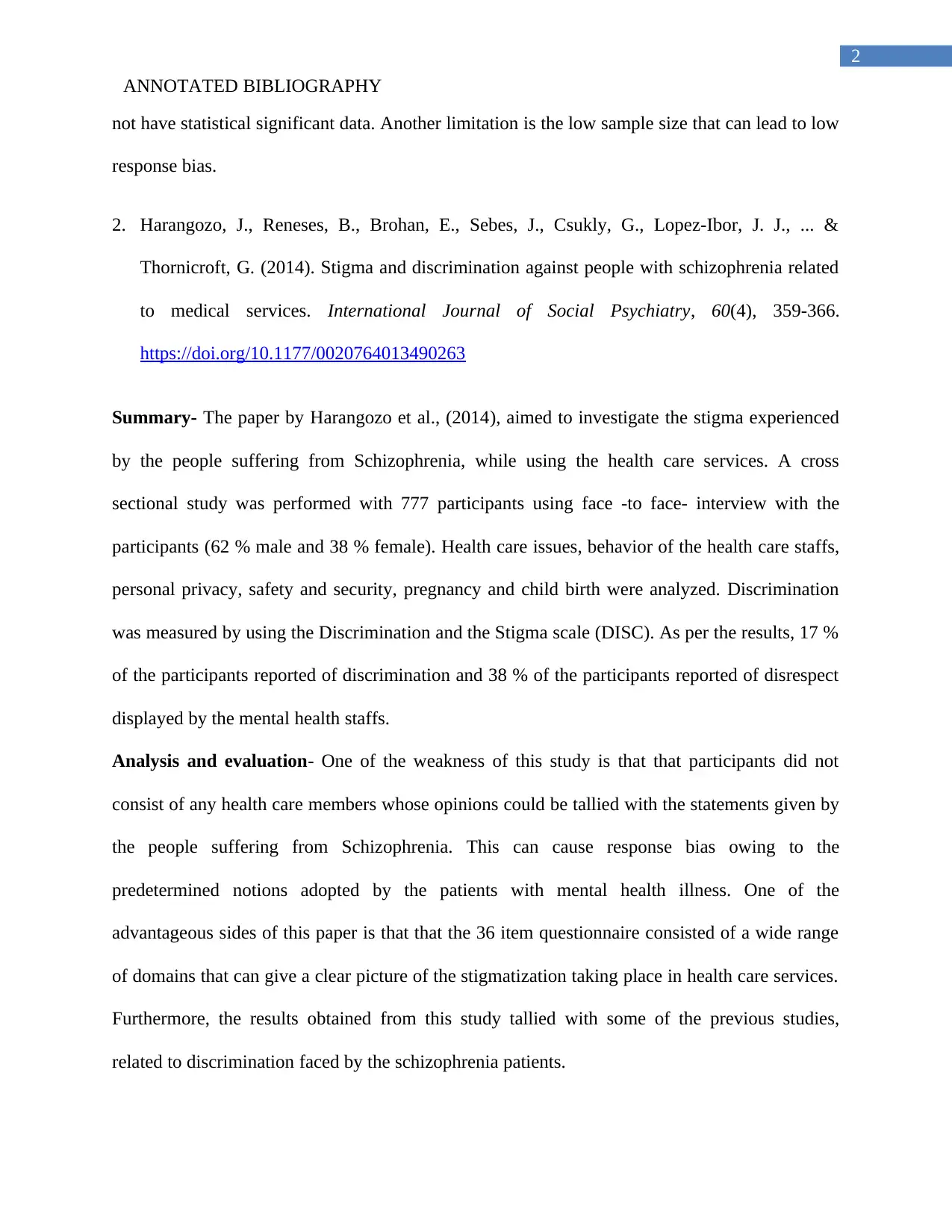
2
ANNOTATED BIBLIOGRAPHY
not have statistical significant data. Another limitation is the low sample size that can lead to low
response bias.
2. Harangozo, J., Reneses, B., Brohan, E., Sebes, J., Csukly, G., Lopez-Ibor, J. J., ... &
Thornicroft, G. (2014). Stigma and discrimination against people with schizophrenia related
to medical services. International Journal of Social Psychiatry, 60(4), 359-366.
https://doi.org/10.1177/0020764013490263
Summary- The paper by Harangozo et al., (2014), aimed to investigate the stigma experienced
by the people suffering from Schizophrenia, while using the health care services. A cross
sectional study was performed with 777 participants using face -to face- interview with the
participants (62 % male and 38 % female). Health care issues, behavior of the health care staffs,
personal privacy, safety and security, pregnancy and child birth were analyzed. Discrimination
was measured by using the Discrimination and the Stigma scale (DISC). As per the results, 17 %
of the participants reported of discrimination and 38 % of the participants reported of disrespect
displayed by the mental health staffs.
Analysis and evaluation- One of the weakness of this study is that that participants did not
consist of any health care members whose opinions could be tallied with the statements given by
the people suffering from Schizophrenia. This can cause response bias owing to the
predetermined notions adopted by the patients with mental health illness. One of the
advantageous sides of this paper is that that the 36 item questionnaire consisted of a wide range
of domains that can give a clear picture of the stigmatization taking place in health care services.
Furthermore, the results obtained from this study tallied with some of the previous studies,
related to discrimination faced by the schizophrenia patients.
ANNOTATED BIBLIOGRAPHY
not have statistical significant data. Another limitation is the low sample size that can lead to low
response bias.
2. Harangozo, J., Reneses, B., Brohan, E., Sebes, J., Csukly, G., Lopez-Ibor, J. J., ... &
Thornicroft, G. (2014). Stigma and discrimination against people with schizophrenia related
to medical services. International Journal of Social Psychiatry, 60(4), 359-366.
https://doi.org/10.1177/0020764013490263
Summary- The paper by Harangozo et al., (2014), aimed to investigate the stigma experienced
by the people suffering from Schizophrenia, while using the health care services. A cross
sectional study was performed with 777 participants using face -to face- interview with the
participants (62 % male and 38 % female). Health care issues, behavior of the health care staffs,
personal privacy, safety and security, pregnancy and child birth were analyzed. Discrimination
was measured by using the Discrimination and the Stigma scale (DISC). As per the results, 17 %
of the participants reported of discrimination and 38 % of the participants reported of disrespect
displayed by the mental health staffs.
Analysis and evaluation- One of the weakness of this study is that that participants did not
consist of any health care members whose opinions could be tallied with the statements given by
the people suffering from Schizophrenia. This can cause response bias owing to the
predetermined notions adopted by the patients with mental health illness. One of the
advantageous sides of this paper is that that the 36 item questionnaire consisted of a wide range
of domains that can give a clear picture of the stigmatization taking place in health care services.
Furthermore, the results obtained from this study tallied with some of the previous studies,
related to discrimination faced by the schizophrenia patients.
⊘ This is a preview!⊘
Do you want full access?
Subscribe today to unlock all pages.

Trusted by 1+ million students worldwide
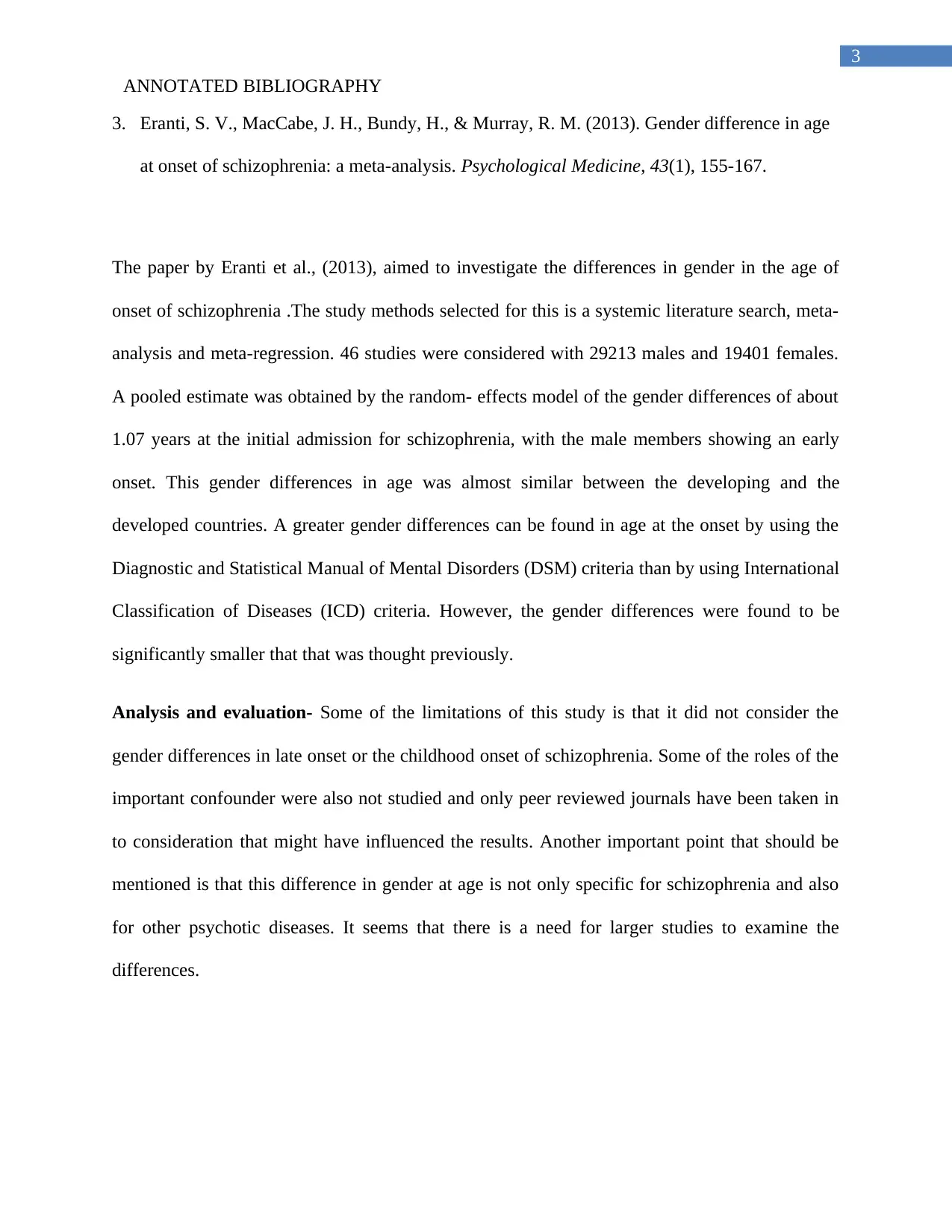
3
ANNOTATED BIBLIOGRAPHY
3. Eranti, S. V., MacCabe, J. H., Bundy, H., & Murray, R. M. (2013). Gender difference in age
at onset of schizophrenia: a meta-analysis. Psychological Medicine, 43(1), 155-167.
The paper by Eranti et al., (2013), aimed to investigate the differences in gender in the age of
onset of schizophrenia .The study methods selected for this is a systemic literature search, meta-
analysis and meta-regression. 46 studies were considered with 29213 males and 19401 females.
A pooled estimate was obtained by the random- effects model of the gender differences of about
1.07 years at the initial admission for schizophrenia, with the male members showing an early
onset. This gender differences in age was almost similar between the developing and the
developed countries. A greater gender differences can be found in age at the onset by using the
Diagnostic and Statistical Manual of Mental Disorders (DSM) criteria than by using International
Classification of Diseases (ICD) criteria. However, the gender differences were found to be
significantly smaller that that was thought previously.
Analysis and evaluation- Some of the limitations of this study is that it did not consider the
gender differences in late onset or the childhood onset of schizophrenia. Some of the roles of the
important confounder were also not studied and only peer reviewed journals have been taken in
to consideration that might have influenced the results. Another important point that should be
mentioned is that this difference in gender at age is not only specific for schizophrenia and also
for other psychotic diseases. It seems that there is a need for larger studies to examine the
differences.
ANNOTATED BIBLIOGRAPHY
3. Eranti, S. V., MacCabe, J. H., Bundy, H., & Murray, R. M. (2013). Gender difference in age
at onset of schizophrenia: a meta-analysis. Psychological Medicine, 43(1), 155-167.
The paper by Eranti et al., (2013), aimed to investigate the differences in gender in the age of
onset of schizophrenia .The study methods selected for this is a systemic literature search, meta-
analysis and meta-regression. 46 studies were considered with 29213 males and 19401 females.
A pooled estimate was obtained by the random- effects model of the gender differences of about
1.07 years at the initial admission for schizophrenia, with the male members showing an early
onset. This gender differences in age was almost similar between the developing and the
developed countries. A greater gender differences can be found in age at the onset by using the
Diagnostic and Statistical Manual of Mental Disorders (DSM) criteria than by using International
Classification of Diseases (ICD) criteria. However, the gender differences were found to be
significantly smaller that that was thought previously.
Analysis and evaluation- Some of the limitations of this study is that it did not consider the
gender differences in late onset or the childhood onset of schizophrenia. Some of the roles of the
important confounder were also not studied and only peer reviewed journals have been taken in
to consideration that might have influenced the results. Another important point that should be
mentioned is that this difference in gender at age is not only specific for schizophrenia and also
for other psychotic diseases. It seems that there is a need for larger studies to examine the
differences.
Paraphrase This Document
Need a fresh take? Get an instant paraphrase of this document with our AI Paraphraser
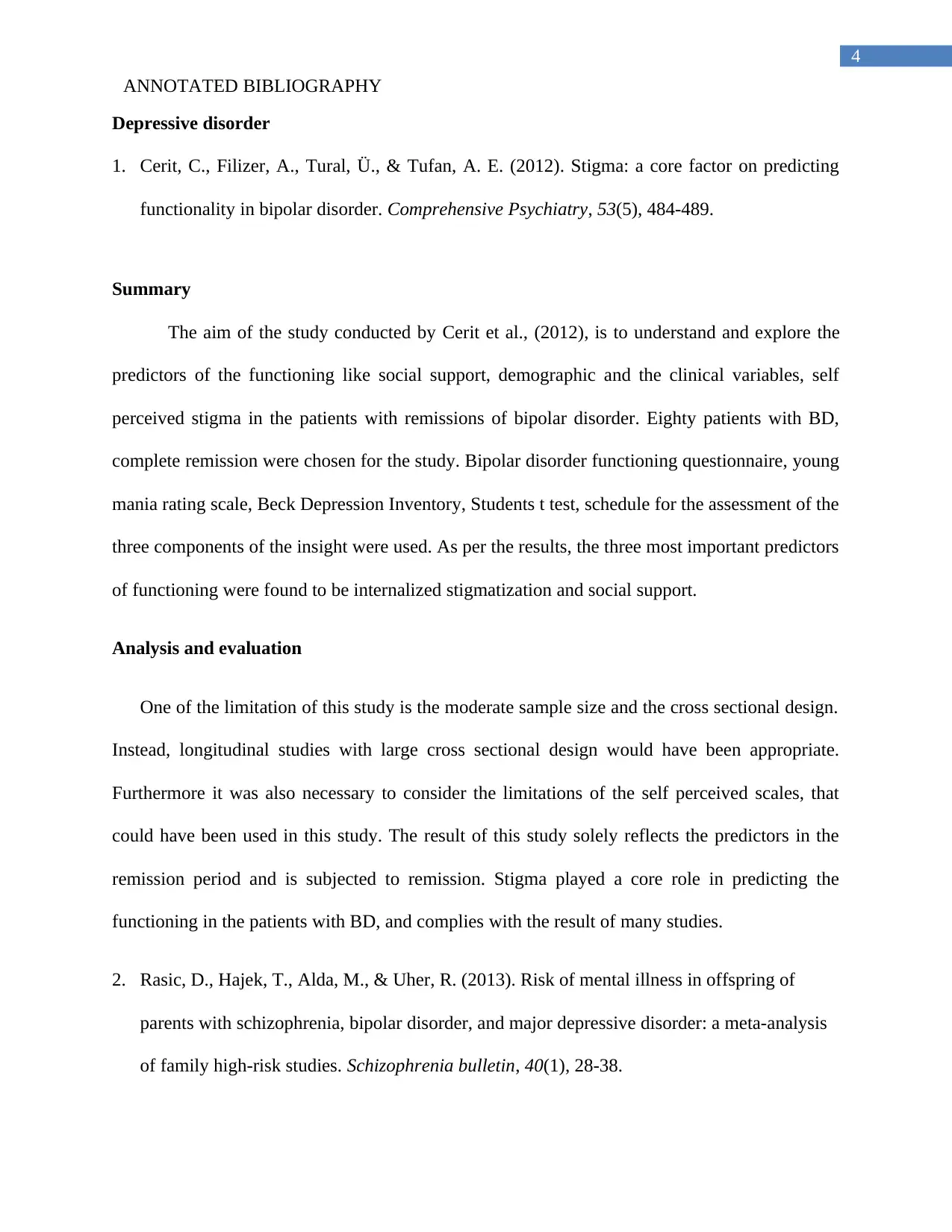
4
ANNOTATED BIBLIOGRAPHY
Depressive disorder
1. Cerit, C., Filizer, A., Tural, Ü., & Tufan, A. E. (2012). Stigma: a core factor on predicting
functionality in bipolar disorder. Comprehensive Psychiatry, 53(5), 484-489.
Summary
The aim of the study conducted by Cerit et al., (2012), is to understand and explore the
predictors of the functioning like social support, demographic and the clinical variables, self
perceived stigma in the patients with remissions of bipolar disorder. Eighty patients with BD,
complete remission were chosen for the study. Bipolar disorder functioning questionnaire, young
mania rating scale, Beck Depression Inventory, Students t test, schedule for the assessment of the
three components of the insight were used. As per the results, the three most important predictors
of functioning were found to be internalized stigmatization and social support.
Analysis and evaluation
One of the limitation of this study is the moderate sample size and the cross sectional design.
Instead, longitudinal studies with large cross sectional design would have been appropriate.
Furthermore it was also necessary to consider the limitations of the self perceived scales, that
could have been used in this study. The result of this study solely reflects the predictors in the
remission period and is subjected to remission. Stigma played a core role in predicting the
functioning in the patients with BD, and complies with the result of many studies.
2. Rasic, D., Hajek, T., Alda, M., & Uher, R. (2013). Risk of mental illness in offspring of
parents with schizophrenia, bipolar disorder, and major depressive disorder: a meta-analysis
of family high-risk studies. Schizophrenia bulletin, 40(1), 28-38.
ANNOTATED BIBLIOGRAPHY
Depressive disorder
1. Cerit, C., Filizer, A., Tural, Ü., & Tufan, A. E. (2012). Stigma: a core factor on predicting
functionality in bipolar disorder. Comprehensive Psychiatry, 53(5), 484-489.
Summary
The aim of the study conducted by Cerit et al., (2012), is to understand and explore the
predictors of the functioning like social support, demographic and the clinical variables, self
perceived stigma in the patients with remissions of bipolar disorder. Eighty patients with BD,
complete remission were chosen for the study. Bipolar disorder functioning questionnaire, young
mania rating scale, Beck Depression Inventory, Students t test, schedule for the assessment of the
three components of the insight were used. As per the results, the three most important predictors
of functioning were found to be internalized stigmatization and social support.
Analysis and evaluation
One of the limitation of this study is the moderate sample size and the cross sectional design.
Instead, longitudinal studies with large cross sectional design would have been appropriate.
Furthermore it was also necessary to consider the limitations of the self perceived scales, that
could have been used in this study. The result of this study solely reflects the predictors in the
remission period and is subjected to remission. Stigma played a core role in predicting the
functioning in the patients with BD, and complies with the result of many studies.
2. Rasic, D., Hajek, T., Alda, M., & Uher, R. (2013). Risk of mental illness in offspring of
parents with schizophrenia, bipolar disorder, and major depressive disorder: a meta-analysis
of family high-risk studies. Schizophrenia bulletin, 40(1), 28-38.
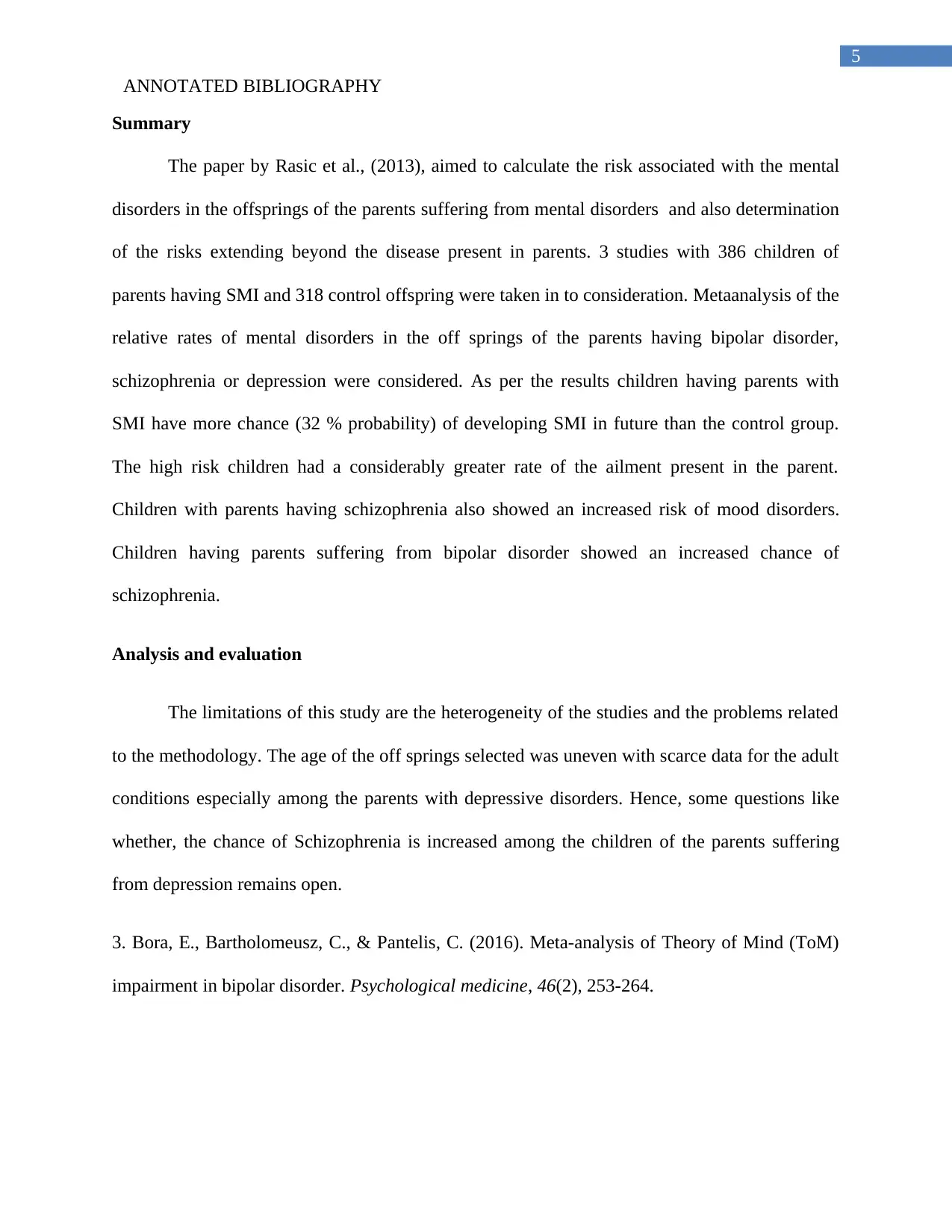
5
ANNOTATED BIBLIOGRAPHY
Summary
The paper by Rasic et al., (2013), aimed to calculate the risk associated with the mental
disorders in the offsprings of the parents suffering from mental disorders and also determination
of the risks extending beyond the disease present in parents. 3 studies with 386 children of
parents having SMI and 318 control offspring were taken in to consideration. Metaanalysis of the
relative rates of mental disorders in the off springs of the parents having bipolar disorder,
schizophrenia or depression were considered. As per the results children having parents with
SMI have more chance (32 % probability) of developing SMI in future than the control group.
The high risk children had a considerably greater rate of the ailment present in the parent.
Children with parents having schizophrenia also showed an increased risk of mood disorders.
Children having parents suffering from bipolar disorder showed an increased chance of
schizophrenia.
Analysis and evaluation
The limitations of this study are the heterogeneity of the studies and the problems related
to the methodology. The age of the off springs selected was uneven with scarce data for the adult
conditions especially among the parents with depressive disorders. Hence, some questions like
whether, the chance of Schizophrenia is increased among the children of the parents suffering
from depression remains open.
3. Bora, E., Bartholomeusz, C., & Pantelis, C. (2016). Meta-analysis of Theory of Mind (ToM)
impairment in bipolar disorder. Psychological medicine, 46(2), 253-264.
ANNOTATED BIBLIOGRAPHY
Summary
The paper by Rasic et al., (2013), aimed to calculate the risk associated with the mental
disorders in the offsprings of the parents suffering from mental disorders and also determination
of the risks extending beyond the disease present in parents. 3 studies with 386 children of
parents having SMI and 318 control offspring were taken in to consideration. Metaanalysis of the
relative rates of mental disorders in the off springs of the parents having bipolar disorder,
schizophrenia or depression were considered. As per the results children having parents with
SMI have more chance (32 % probability) of developing SMI in future than the control group.
The high risk children had a considerably greater rate of the ailment present in the parent.
Children with parents having schizophrenia also showed an increased risk of mood disorders.
Children having parents suffering from bipolar disorder showed an increased chance of
schizophrenia.
Analysis and evaluation
The limitations of this study are the heterogeneity of the studies and the problems related
to the methodology. The age of the off springs selected was uneven with scarce data for the adult
conditions especially among the parents with depressive disorders. Hence, some questions like
whether, the chance of Schizophrenia is increased among the children of the parents suffering
from depression remains open.
3. Bora, E., Bartholomeusz, C., & Pantelis, C. (2016). Meta-analysis of Theory of Mind (ToM)
impairment in bipolar disorder. Psychological medicine, 46(2), 253-264.
⊘ This is a preview!⊘
Do you want full access?
Subscribe today to unlock all pages.

Trusted by 1+ million students worldwide
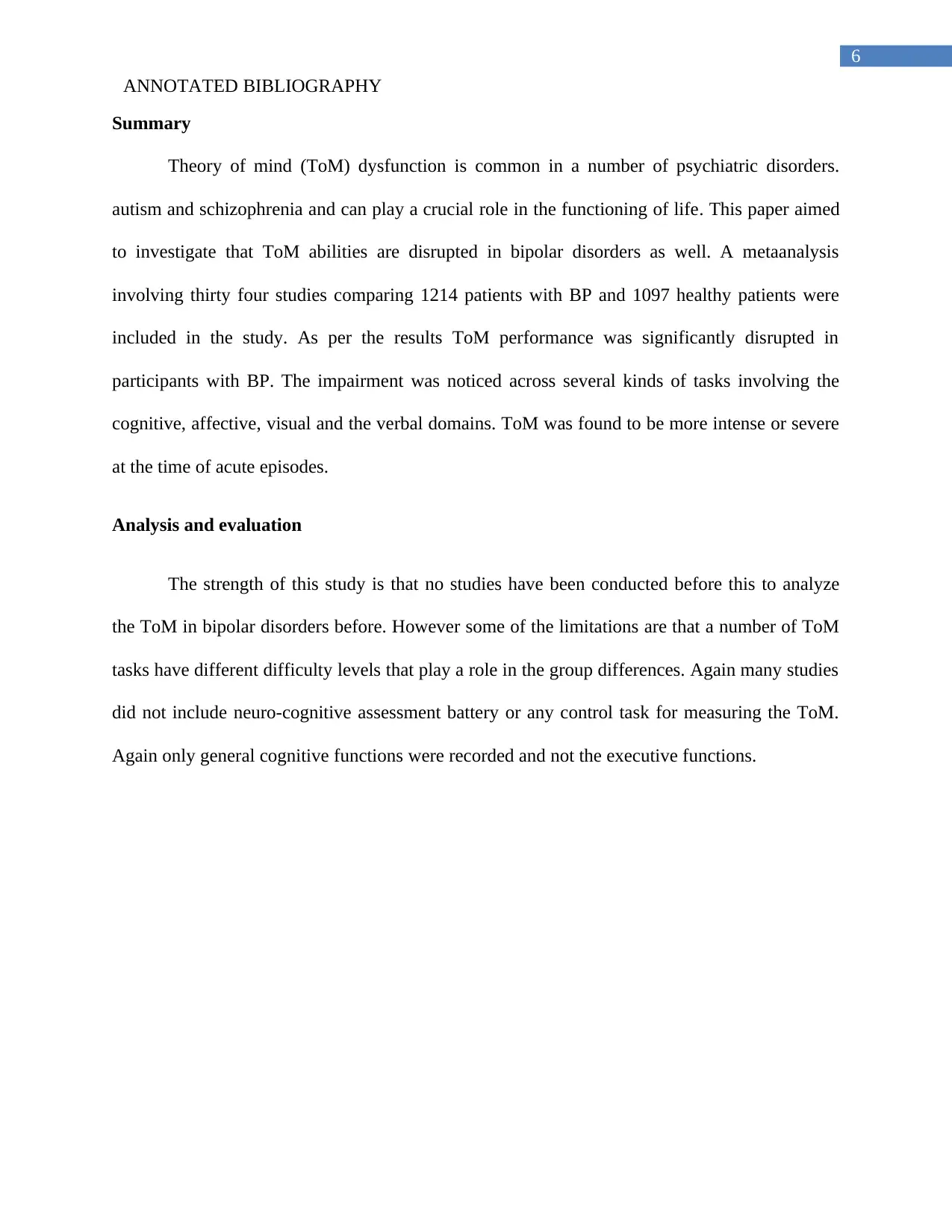
6
ANNOTATED BIBLIOGRAPHY
Summary
Theory of mind (ToM) dysfunction is common in a number of psychiatric disorders.
autism and schizophrenia and can play a crucial role in the functioning of life. This paper aimed
to investigate that ToM abilities are disrupted in bipolar disorders as well. A metaanalysis
involving thirty four studies comparing 1214 patients with BP and 1097 healthy patients were
included in the study. As per the results ToM performance was significantly disrupted in
participants with BP. The impairment was noticed across several kinds of tasks involving the
cognitive, affective, visual and the verbal domains. ToM was found to be more intense or severe
at the time of acute episodes.
Analysis and evaluation
The strength of this study is that no studies have been conducted before this to analyze
the ToM in bipolar disorders before. However some of the limitations are that a number of ToM
tasks have different difficulty levels that play a role in the group differences. Again many studies
did not include neuro-cognitive assessment battery or any control task for measuring the ToM.
Again only general cognitive functions were recorded and not the executive functions.
ANNOTATED BIBLIOGRAPHY
Summary
Theory of mind (ToM) dysfunction is common in a number of psychiatric disorders.
autism and schizophrenia and can play a crucial role in the functioning of life. This paper aimed
to investigate that ToM abilities are disrupted in bipolar disorders as well. A metaanalysis
involving thirty four studies comparing 1214 patients with BP and 1097 healthy patients were
included in the study. As per the results ToM performance was significantly disrupted in
participants with BP. The impairment was noticed across several kinds of tasks involving the
cognitive, affective, visual and the verbal domains. ToM was found to be more intense or severe
at the time of acute episodes.
Analysis and evaluation
The strength of this study is that no studies have been conducted before this to analyze
the ToM in bipolar disorders before. However some of the limitations are that a number of ToM
tasks have different difficulty levels that play a role in the group differences. Again many studies
did not include neuro-cognitive assessment battery or any control task for measuring the ToM.
Again only general cognitive functions were recorded and not the executive functions.
Paraphrase This Document
Need a fresh take? Get an instant paraphrase of this document with our AI Paraphraser
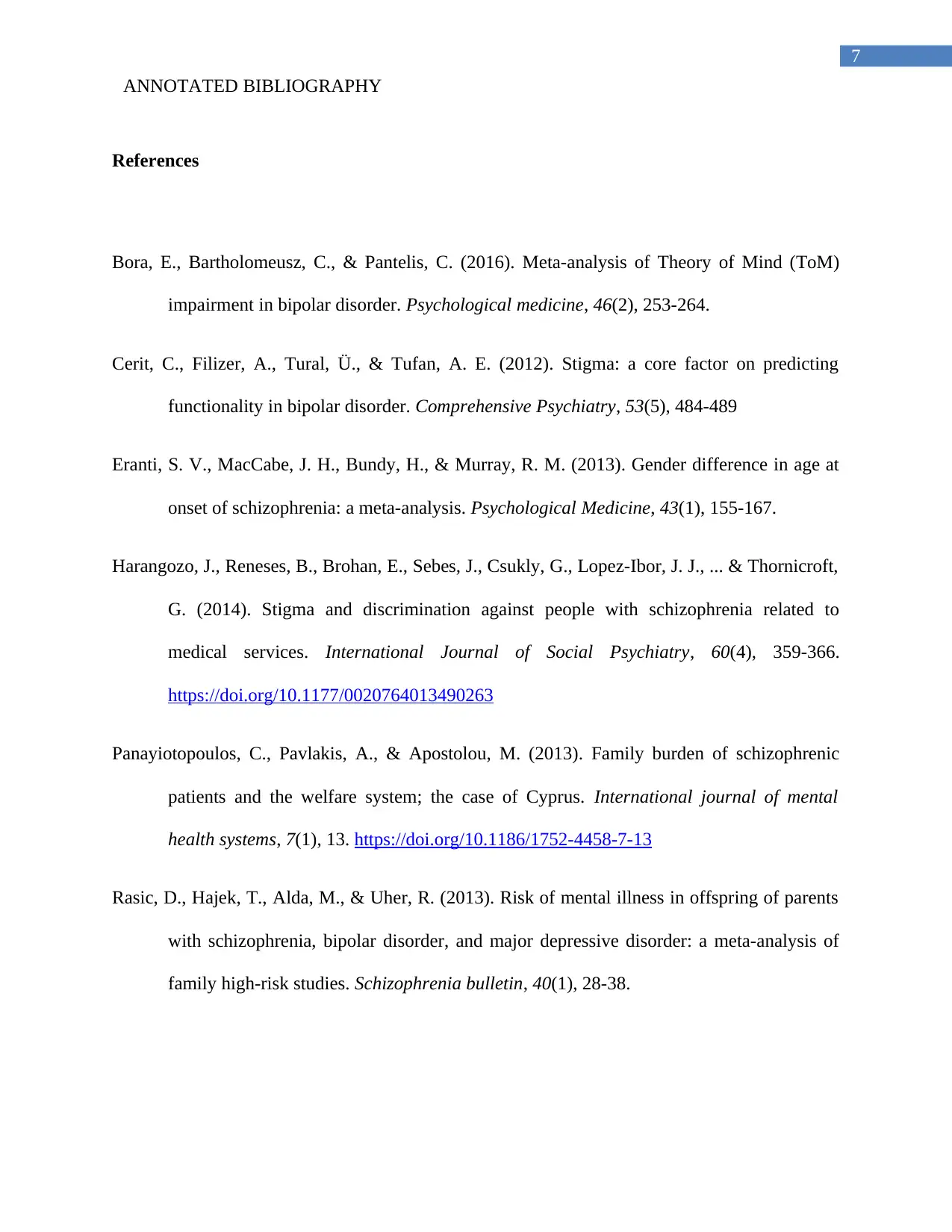
7
ANNOTATED BIBLIOGRAPHY
References
Bora, E., Bartholomeusz, C., & Pantelis, C. (2016). Meta-analysis of Theory of Mind (ToM)
impairment in bipolar disorder. Psychological medicine, 46(2), 253-264.
Cerit, C., Filizer, A., Tural, Ü., & Tufan, A. E. (2012). Stigma: a core factor on predicting
functionality in bipolar disorder. Comprehensive Psychiatry, 53(5), 484-489
Eranti, S. V., MacCabe, J. H., Bundy, H., & Murray, R. M. (2013). Gender difference in age at
onset of schizophrenia: a meta-analysis. Psychological Medicine, 43(1), 155-167.
Harangozo, J., Reneses, B., Brohan, E., Sebes, J., Csukly, G., Lopez-Ibor, J. J., ... & Thornicroft,
G. (2014). Stigma and discrimination against people with schizophrenia related to
medical services. International Journal of Social Psychiatry, 60(4), 359-366.
https://doi.org/10.1177/0020764013490263
Panayiotopoulos, C., Pavlakis, A., & Apostolou, M. (2013). Family burden of schizophrenic
patients and the welfare system; the case of Cyprus. International journal of mental
health systems, 7(1), 13. https://doi.org/10.1186/1752-4458-7-13
Rasic, D., Hajek, T., Alda, M., & Uher, R. (2013). Risk of mental illness in offspring of parents
with schizophrenia, bipolar disorder, and major depressive disorder: a meta-analysis of
family high-risk studies. Schizophrenia bulletin, 40(1), 28-38.
ANNOTATED BIBLIOGRAPHY
References
Bora, E., Bartholomeusz, C., & Pantelis, C. (2016). Meta-analysis of Theory of Mind (ToM)
impairment in bipolar disorder. Psychological medicine, 46(2), 253-264.
Cerit, C., Filizer, A., Tural, Ü., & Tufan, A. E. (2012). Stigma: a core factor on predicting
functionality in bipolar disorder. Comprehensive Psychiatry, 53(5), 484-489
Eranti, S. V., MacCabe, J. H., Bundy, H., & Murray, R. M. (2013). Gender difference in age at
onset of schizophrenia: a meta-analysis. Psychological Medicine, 43(1), 155-167.
Harangozo, J., Reneses, B., Brohan, E., Sebes, J., Csukly, G., Lopez-Ibor, J. J., ... & Thornicroft,
G. (2014). Stigma and discrimination against people with schizophrenia related to
medical services. International Journal of Social Psychiatry, 60(4), 359-366.
https://doi.org/10.1177/0020764013490263
Panayiotopoulos, C., Pavlakis, A., & Apostolou, M. (2013). Family burden of schizophrenic
patients and the welfare system; the case of Cyprus. International journal of mental
health systems, 7(1), 13. https://doi.org/10.1186/1752-4458-7-13
Rasic, D., Hajek, T., Alda, M., & Uher, R. (2013). Risk of mental illness in offspring of parents
with schizophrenia, bipolar disorder, and major depressive disorder: a meta-analysis of
family high-risk studies. Schizophrenia bulletin, 40(1), 28-38.

8
ANNOTATED BIBLIOGRAPHY
ANNOTATED BIBLIOGRAPHY
⊘ This is a preview!⊘
Do you want full access?
Subscribe today to unlock all pages.

Trusted by 1+ million students worldwide
1 out of 9
Related Documents
Your All-in-One AI-Powered Toolkit for Academic Success.
+13062052269
info@desklib.com
Available 24*7 on WhatsApp / Email
![[object Object]](/_next/static/media/star-bottom.7253800d.svg)
Unlock your academic potential
Copyright © 2020–2025 A2Z Services. All Rights Reserved. Developed and managed by ZUCOL.



